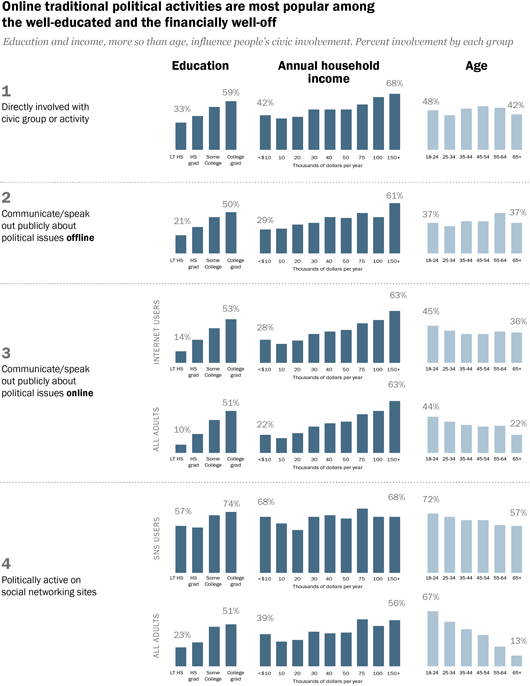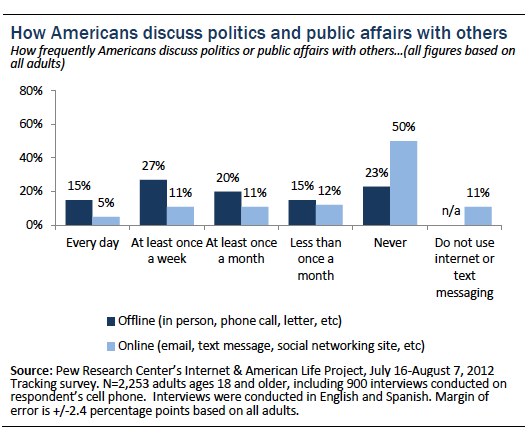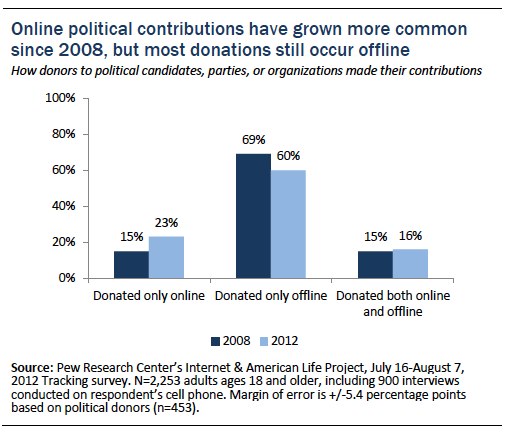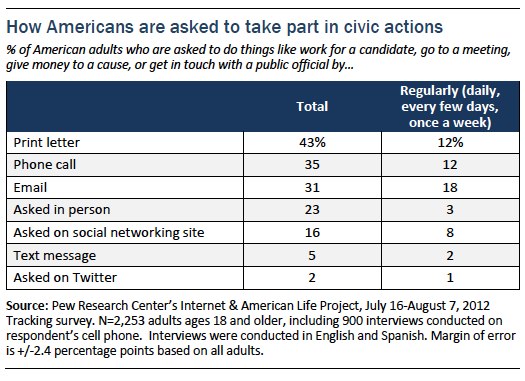Online and offline political engagement
This study examines online and offline political engagement and pays special attention to the role of social networking sites in people’s political activities.1 There are several major findings:
- Class differences, especially those related to educational attainment, are prominent in political engagement of all kinds, whether that activity takes place offline, online, or within the specific context of social networking sites (SNS), though the trend is somewhat more moderate in SNS.
- There has been major growth in political activity on SNS between 2008 and this survey in 2012. The number of social networking site users has grown from 33% of the online population in 2008 to 69% of the online population in 2012. And there have been major jumps in the proportion of SNS users who post political news, who friend or follow candidates, and who joined an SNS group organized around political or social issues. In addition, notable shares of SNS users say their activity on the sites has prompted them to learn more about social or political issues and to take action around those issues.
- For most politically active SNS users, social networking sites are not a separate realm of political activity. They are frequently active in other aspects of civic life.
- Even as online platforms have grown more prominent in political affairs, Americans’ day-to-day political conversations mostly occur offline.
The four ways we measured civic engagement
First, 48% of adults directly take part in a civic group or activity.
In this survey, the Pew Research Center’s Internet & American Life Project measured several broad categories of civic activity that Americans might engage in. The first finding is that half (48%) of American adults directly took part in a civic group or activity in the 12 months preceding our August 2012 survey. This includes anyone who did one or more of the following six activities:
- 35% of American adults have recently worked with fellow citizens to solve a problem in their community
- 22% have attended a political meeting on local, town, or school affairs
- 13% have been an active member of a group that tries to influence the public or government
- 10% have attended a political rally or speech
- 7% have worked or volunteered for a political party or candidate
- 6% have attended an organized protest
Second, 39% of adults recently contacted a government official or spoke out in a public forum via offline methods. Third, 34% did those things via online methods.
In the second category of public engagement, we found that 39% of American adults have recently contacted a government official or spoken out in a public forum about an issue that is important to them via offline means. In the third category, we found that 34% have done so via online methods. This includes anyone who did one or more of the following activities that might take place in either online or offline spaces:
- 22% of American adults have recently signed a paper petition; 17% have signed a petition online.
- 21% of American adults have recently contacted a government official about an issue that is important to them in person, by phone, or by letter; 18% have done so online, by email, or by text message.
- 7% of American adults have recently called into a live radio or TV show to express an opinion about a political or social issue; 18% have commented on an online news story or blog post about this type of issue.
- 3% of American adults have sent a letter to the editor to a newspaper or magazine by regular mail; 4% have done so online, by email, or by text message.
Fourth, 39% of adults do political or civic activities on social networking sites.
In the fourth category, 39% of American adults took part in some sort of political activity in the context of a social networking site such as Facebook or Twitter in the 12 months preceding our survey. This includes anyone who did one or more of the following eight activities listed in the table below:

In total, nearly three-quarters (72%) of all American adults did at least one of the activities that we measured in those four broad categories of civic and political engagement.
Activities
Traditional political activities are most common among the well-educated and financially well-off, regardless of whether they take place online or offline. On social networking sites, income-related differences are more modest — but civic engagement in these spaces is still most prevalent among those with higher educational levels.
Those who live in higher income households and those with higher levels of education (specifically, those who have attended or graduated from college) are consistently more likely than those with lower income or education levels to take part in many of the online and offline civic behaviors we measured in this study. This gap is especially pronounced for the following specific activities:
- Working with fellow citizens to solve a problem in one’s community
- Attending a political meeting on local, town, or school affairs
- Being an active member of a group that tries to influence public policy or government
- Attending a political rally or speech
- Working or volunteering for a political party or candidate
- Contacting a government official about an issue that is important to you (both online and offline)
- Signing a petition (both digitally and on paper)
- Commenting on a news story or blog post online
On the other hand, when it comes to the 60% of American adults who use social networking sites such as Facebook or Twitter, political participation is more balanced between lower and higher income Americans. Among social networking site users, political participation is identical for those who live in the lowest earning households (annual household income of less than $10,000) and highest earning households (annual household income of $150,000 or more).
Higher income Americans are more likely to use social networking sites in the first place, so income-related differences are evident when the base measurement applies to all adults – not just SNS users. But even on an “all adults” basis, the gap in political participation between the lowest and highest income groups is generally smaller on social networking sites than it is for other types of political engagement.
At the same time, even as differences in social networking engagement are less pronounced with respect to income, the college-educated are significantly more likely than those with a high school education to take part in nearly every SNS-related behavior we measured in our survey. And in contrast to income (where SNS users in the lowest and highest categories were equally likely to use these sites for political reasons) these educational differences persist even when we account for different levels of adoption between those with lower and higher education levels.
In other words, even as the impact of income on political participation is more modest in the context of social networking sites, socio-economic distinctions related to education still play a prominent role in these spaces.
More broadly, those at the lower end of the socio-economic spectrum are generally less involved with the day-to-day outreach, chatter, and discussion around political issues — regardless of whether those discussions take place in physical or digital spaces. Compared with the well-educated and financially well-off, they are much less likely to receive political communications through a variety of channels, or to have conversations about political or social issues with others in either online or offline venues. Ultimately, political issues, political activity, and political discussion are less present in the lives of these Americans than they are for those at the upper end of the socio-economic scale.
Younger adults are just as likely as older adults to be engaged in many political activities, and are much more likely to be politically active on social networking sites.
Most types of political engagement are equally commonplace among Americans of different generations. There are only modest age-related differences when it comes to getting involved in political groups or in-person activities, speaking out publicly in online spaces, or speaking out publicly in offline spaces.2
Social networking sites (SNS) stand in contrast to these other venues. Political engagement on social networking sites is especially commonplace among the youngest Americans, as two-thirds (67%) of all 18-24 year olds (and nearly three quarters of those young adults who use social networking sites) engaged in some sort of social network-related political activity in the 12 months preceding our survey. Older adults tend to be fairly politically active on social networking sites to the extent that they use them, but are relatively unlikely to use these sites in the first place. So, although nearly six in ten SNS-using seniors are politically active on these sites, that works out to just 13% of all Americans in the 65+ age group.
Indeed, the youngest American adults are more likely to engage in political behaviors on social networking sites than in any other venue. And the typical (median) 18-29 year old took part in three of the eight SNS-oriented political behaviors measured in this survey. The general youth of the “political SNS user” group also helps to explain the balance between high- and low-income users when it comes to political activity in these spaces, since many of these younger adults are only beginning their careers and have not fully maximized their earning potential.

Click to view a larger version of the image.
There has been major growth in political activity on social networking sites since 2008, and discussions on social networking sites can lead to further engagement with political issues.
The structure of political activity on social networking sites has grown in importance in recent years. The number of social networking site users has grown from 33% of the online population in 20083 to 69% of the online population in 2012. And as the overall SNS user population has grown, more of these users are engaging in one way or another with political or social issues on these sites, compared with 2008 when we asked a similar set of questions about this subject. Here are some of the key areas of growth:
- In 2008, 11% of social networking site users said that they used these sites to post political news for others to read — at the time that worked out to just 3% of all adults. In 2012, 28% of SNS users (representing 17% of all adults) said they posted links to political stories or articles and 33% (representing 19% of all adults) said they posted other types of political content on these sites.
- In 2008, 12% of social networking site users (representing 3% of all adults) said they had friended a political candidate on these sites. In 2012, 20% of users (representing 12% of all adults) said they have friended or followed a candidate or similar political figure.
- In 2008, 13% of users (representing 3% of all adults) said they had started or joined a group on a social networking site organized around political or social issues. By 2012, the proportion of social networking site users who do this had risen to 21% (12% of all adults).
We also asked directly about the impact of social networking site discussions on users’ political behaviors and found that:
- 43% of social networking site users say they have decided to learn more about a political or social issue because of something they read about on a social networking site.
- 18% of social networking site users say they have decided to take action involving a political or social issue because of something they read on those sites.
In each instance, users were evenly split between those who found out about the issue in question from someone they know personally, and those who found out about it from someone they don’t know personally, such as an organization or public figure. Younger SNS users are especially likely to engage in deeper investigations of issues based on discussions within those sites, as are those with a college degree.
The world of politics on social networking sites is — for most users — not a separate domain of political activity. “Political social networking site users” are frequently (but not universally) active in other aspects of civic life.
Many discussions about the impact of the internet on political and civic life assume that the people who take part in political activities on social networking sites are separate and distinct from those who take part in political activities outside social networking sites. In fact, the typical politically active American is active in a range of venues — online, offline, and in social networking spaces — and those who get involved politically on social networking sites tend to take part in a wide range of behaviors that occur outside the boundaries of sites like Facebook or Twitter.
As noted above, 39% of Americans performed some sort of political activity on a social networking site in the 12 months preceding our survey. We refer to them throughout this report as “political social networking site (SNS) users,” and these users tend to be active in many other areas of political or civic life:
- 63% of political SNS users have recently gotten involved in a political activity or group, such as attending a political meeting or working with fellow citizens to solve a problem in their community. The national average is 48%.
- 60% have expressed their opinion about a political or social issue via online channels — for example, by sending an email to a government official, or signing an online petition. The national average is 34%.
- 53% have expressed their opinion about a political or social issue via offline channels, for example, by sending a letter to a government official, or signing a paper petition. The national average is 39%.
- 20% have made a political contribution of some kind. This is statistically similar to the 16% rate within the population as a whole.
Adding these four categories together, some 83% of political SNS users also get involved in political or social issues in one way or another outside the bounds of social networking sites themselves.4
Of course, this also means that 17% of political SNS users — representing 8% of the total adult population — engage in political activity on social networking sites but in no other online or offline venues. Demographically, this “politically active on social networking sites but not elsewhere” group tends to be younger, less affluent, and less well-educated than the larger group that participates politically on social networking spaces and also other venues. They also have less overall exposure to political communications and outreach, and are less likely to take part in interpersonal political “chatter.” In other words, even as they interact with political issues on social networking sites, they tend to get involved with those issues with only modest intensity.
Even as online platforms have grown more prominent in recent years, Americans’ day-to-day political conversations — and political contributions —are still more likely to take place offline.
Despite the increased prominence of online platforms when it comes to Americans’ political activity, much of the day-to-day conversation around these issues takes place in traditional (offline) channels. On an “every day” level, Americans are three times as likely to discuss politics or public affairs with others through offline channels (in person, by phone call, or by letter) as they are through online channels. Even the most tech-savvy users — such as young adults, college graduates, or those with high incomes—discuss politics with greater frequency offline than online.

Similarly, the bulk of political campaign contributions happen offline, even as online donations have grown more prominent in recent years. Some 23% of political donors made only online contributions in 2012, yet the substantial majority of political donors (60%) make contributions only via offline methods (that is, in person, over the telephone, or via regular mail).

Mobilization and Outreach: Email and social network users are frequently contacted and asked to take part in civic activities within those online spaces.
Although online tools play a secondary role in Americans’ day-to-day political discussions with others, they have more prominence when it comes to outreach by groups or organizations looking to encourage political action (such as donating money, contacting a public official, or working for a candidate or cause). Email is particularly notable in this regard: 21% of email users regularly get asked on email to take some action around a political or social issue — that works out to 18% of all Americans who regularly receive mobilization messages via email. Social network users also tend to receive relatively frequent calls to action within the context of these sites, as 13% of SNS users (representing 8% of all adults) regularly receive outreach messages on these sites.
Taking all of these communications modes together, some 65% of Americans are contacted at least occasionally by groups or individuals asking them to take some sort of civic or political action, with 33% saying they are contacted for this reason on a regular basis (once a week or more frequently). As with many of the civic behaviors discussed here, these contacts are reported more frequently by those with relatively high income and education levels, and those who receive frequent political communications tend to be highly active in various online and offline venues.

There are also some partisan differences among the different types of outreach. Conservatives and Republicans are more likely than liberals and Democrats to receive political “calls to action” in the mail, while liberals and Democrats are more likely than conservatives and Republicans to receive these messages on social networking sites.
Those who have been affected by the recent economic downturn are actively involved with political and social issues across a range of platforms.
Overall, some 56% of the population has experienced one or more of the following impacts in the preceding year as a result of the recent economic slowdown:
- 46% have cut back on the amount or quality of food they purchase
- 38% have put off medical or dental treatment
- 25% have delayed making a rent or house payment
Members of this “economically affected” group tend to have relatively low incomes compared with those who have not experienced these impacts, but are also relatively young and well-educated as a group. Moreover, the economically affected are fairly active when it comes to expressing themselves about the issues of the day in various online and offline venues. Compared with the 44% of Americans who have not experienced any of these impacts:
- The “economically affected” are no less likely to own a cell phone, to use the internet, or to use social networking sites.
- They are equally likely to directly take part in an in-person political group or activity. Indeed, they are slightly more likely to have recently attended an organized protest or a local political meeting.
- They are equally likely to receive political outreach messages across a range of platforms.
- They are equally likely to publicly speak out about issues that are important to them in online forums, and a bit more likely (by a 41%-36% margin) to do so in offline forums.
- They are equally likely to take part in political actions or discussions on social networking sites, and are in fact a bit more likely (by a 35%-27% margin) to encourage others to take action about issues that are important to them on these spaces.
Campaign donations are one of the few areas where the “affected” stand out from the rest of the population. Some 13% have made a campaign contribution in the year preceding our survey (compared with 20% of those who have not experienced any of these impacts).
About this survey
This report is based on the findings of a survey on Americans’ use of the Internet. The results in this report are based on data from telephone interviews conducted by Princeton Survey Research Associates International from July 16 to August 7, 2012, among a sample of 2,253 adults, age 18 and older. Telephone interviews were conducted in English and Spanish by landline (1,353) and cell phone (900, including 469 without a landline phone). For results based on the total sample, one can say with 95% confidence that the error attributable to sampling is plus or minus 2.3 percentage points. For results based Internet users (n=1,873), the margin of sampling error is plus or minus 2.5 percentage points.
Acknowledgements
We would like to thank Sidney Verba, Kay Lehman Schlozman, and Henry Brady for generously contributing their time and expertise to the development of surveys of civic engagement in both 2008 and 2012.


